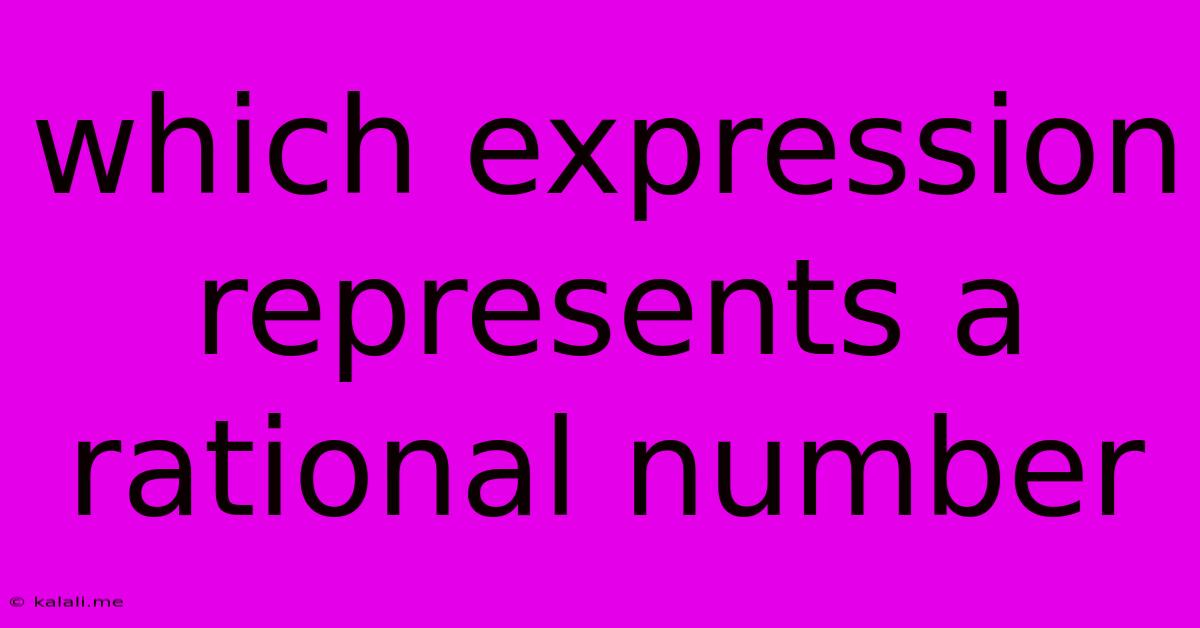Which Expression Represents A Rational Number
Kalali
May 09, 2025 · 3 min read

Table of Contents
Which Expression Represents a Rational Number? A Comprehensive Guide
Meta Description: Learn how to identify rational numbers! This guide explains what rational numbers are, provides examples of expressions representing them, and clarifies common misconceptions. Master the concept and confidently solve related problems.
A rational number is any number that can be expressed as a fraction p/q, where p and q are integers, and q is not equal to zero. Understanding this definition is crucial to identifying which expressions represent rational numbers. This article will explore various expressions and demonstrate how to determine whether they represent rational numbers.
Understanding Rational Numbers
Before diving into expressions, let's solidify our understanding of rational numbers. They encompass a broad range of numbers, including:
- Integers: Whole numbers, both positive and negative (e.g., -3, 0, 5). These can be expressed as fractions with a denominator of 1 (e.g., -3/1, 0/1, 5/1).
- Fractions: Numbers expressed as a ratio of two integers (e.g., 1/2, -3/4, 7/10).
- Terminating Decimals: Decimals that end after a finite number of digits (e.g., 0.25, -1.75, 3.125). These can always be converted into fractions.
- Repeating Decimals: Decimals with a pattern of digits that repeats infinitely (e.g., 0.333..., 0.142857142857...). While seemingly infinite, these can also be converted into fractions.
Expressions Representing Rational Numbers
Now, let's analyze various mathematical expressions to determine if they represent rational numbers.
1. Simple Fractions: These are the most straightforward examples. Any expression in the form p/q, where p and q are integers and q ≠ 0, represents a rational number.
- Examples: 2/3, -5/7, 10/1, -12/15
2. Terminating Decimals: As mentioned earlier, these can be easily converted into fractions.
- Example: 0.75 can be written as 75/100, which simplifies to 3/4.
3. Repeating Decimals: Although they seem infinite, repeating decimals have a specific pattern that allows for conversion to fractions. The process might be more complex, but the result is always a fraction.
- Example: 0.333... can be represented by the fraction 1/3.
4. Expressions that Simplify to Fractions: Some expressions, after simplification or calculation, result in a fraction. These also represent rational numbers.
- Example: The square root of 9 (√9) simplifies to 3, which is a rational number (3/1). However, √2 is irrational.
5. Integer Operations: Arithmetic operations involving integers (addition, subtraction, multiplication, and division, excluding division by zero) always result in rational numbers.
- Example: (5 + 2)/3 simplifies to 7/3.
Expressions that Do Not Represent Rational Numbers
Crucially, understanding what isn't a rational number is just as important.
- Irrational Numbers: These numbers cannot be expressed as a fraction of two integers. The most famous example is π (pi), approximately 3.14159..., and √2. These have infinite, non-repeating decimal expansions.
- Expressions with Undefined Results: Any expression resulting in division by zero is undefined and therefore not a rational number.
Identifying Rational Numbers: A Practical Approach
To determine if an expression represents a rational number, follow these steps:
- Simplify the expression: Perform any calculations or simplifications possible.
- Check the result: Can the result be expressed as a fraction p/q, where p and q are integers, and q ≠ 0? If yes, it's a rational number. If it involves irrational numbers (like π or √2 without simplification to a rational), or results in division by zero, it is not a rational number.
By understanding the definition of rational numbers and following these steps, you can confidently identify which expressions represent rational numbers and master this fundamental concept in mathematics.
Latest Posts
Latest Posts
-
How Many Inches In 6 Feet Tall
May 09, 2025
-
25 Degrees Celsius Equals What Fahrenheit
May 09, 2025
-
Life Cycle Of A Conifer Tree
May 09, 2025
-
What Is The Least Common Multiple Of 8 And 11
May 09, 2025
-
How Many Hours Is 156 Minutes
May 09, 2025
Related Post
Thank you for visiting our website which covers about Which Expression Represents A Rational Number . We hope the information provided has been useful to you. Feel free to contact us if you have any questions or need further assistance. See you next time and don't miss to bookmark.